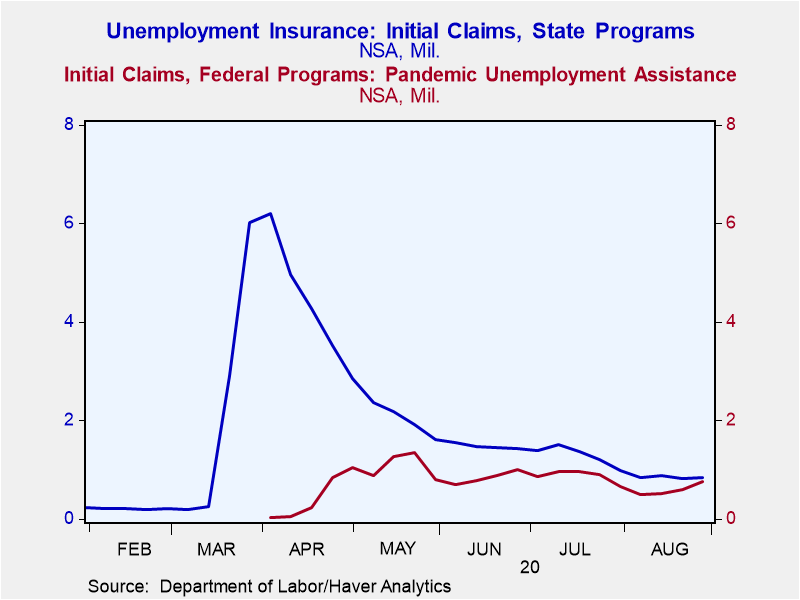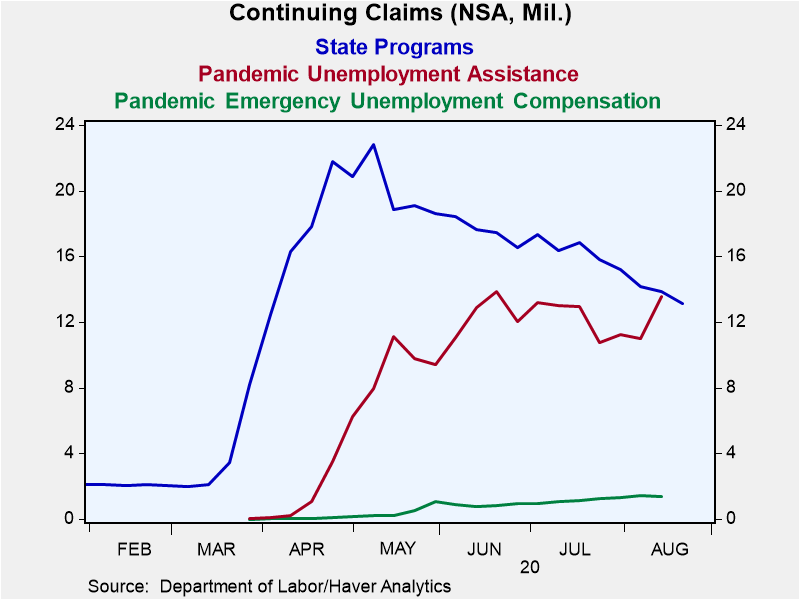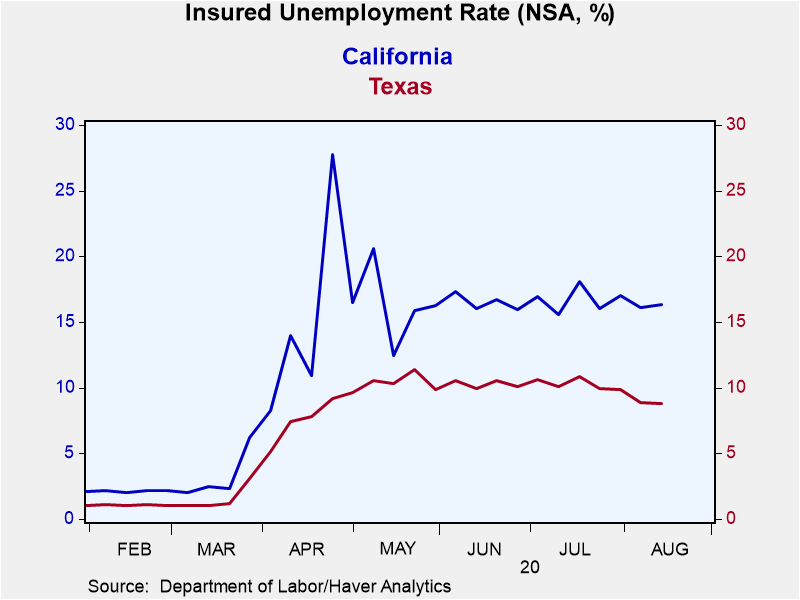 Global| Sep 03 2020
Global| Sep 03 2020New Seasonal Adjustment Complicates U.S. State Claims Data
Summary
• A shift from multiplicative to additive seasonal factors causes break in seasonally adjusted data, shifting focus to not-seasonally-adjusted data. • Not seasonally adjusted state initial jobless claims rose to 833,352 in the week [...]
• A shift from multiplicative to additive seasonal factors causes break in seasonally adjusted data, shifting focus to not-seasonally-adjusted data.
• Not seasonally adjusted state initial jobless claims rose to 833,352 in the week ending August 29.
• Haver Analytics calculated methodology consistent seasonally adjusted claims increases to 883,000.
• Federal Pandemic Unemployment Assistance new filers increased to 759,482, the third consecutive gain.
• Continuing claims for state programs down to 13.1 million; PUA increases to 13.6 million.
Seasonally adjusted state initial jobless claims for unemployment insurance declined to 881,000 in the week ending August 29 from 1.011 million. However, a change in the calculation of seasonal adjustment factors has created a break in the series. That's because the Department of Labor (DoL) is now using additive seasonal factors for the latest week after using multiplicative seasonal factors in previous weeks. DoL noted the reason for the change is that "in the presence of a large level shift in a time series, multiplicative seasonal adjustment factors can result in systematic over- or under-adjustment of the series; in such cases, additive seasonal adjustment factors are preferred since they tend to more accurately track seasonal fluctuations in the series and have smaller revisions." Unfortunately, DoL did not revise the history, so a comparison of August 29 data to the August 22 reflects two different seasonal adjustment factors (the four-week average of seasonally adjusted claims also suffers from this problem). As DoL indicates in the press release they will review and update seasonal factors early next year.
As a result, we will focus on the not seasonally adjusted data, which for initial claims rose to 833,352 in the week ending August 29 from 825,761 in the previous week. Haver Analytics has calculated methodologically consistent seasonally adjusted data with additive seasonal factors, this shows claims increasing to 883,000 from 863,000.
Claims for the federal Pandemic Unemployment Assistance (PUA) program, which covers individuals such as the self-employed who are not qualified for regular/state unemployment insurance, increased for the third consecutive week to 759,482 from 607,808. Numbers for this and other federal programs are not seasonally adjusted.
Seasonally adjusted state continuing claims for unemployment insurance decreased to 13.254 million in the week ending August 22, from a 14.492 million. However, state continuing claims suffer from the same seasonal adjustment related break. Not seasonally adjusted continuing claims declined to 13.104 from 13.869 million. Haver Analytics methodologically consistent additive seasonally adjusted continuing claims fell to 13.236 million from 13.946 million.
Continuing PUA claims, which are lagged an additional week and not seasonally adjusted, jumped to 13.570 million from a 10.973 million. Pandemic Emergency Unemployment Compensation claims declined to 1.393 million in the week ending August 15. This is first weekly decrease since mid-June. This program covers people who were unemployed before COVID but exhausted their state benefits and are now eligible to receive an additional 13 weeks of unemployment insurance, up to a total of 39 weeks.
The seasonally adjusted state insured rate of unemployment -- which also had a break in the series -- fell to 9.1% in the week ending August 22 from 9.9%. The not-seasonally-adjusted data decreased to 9.0% from 9.5%. This data does not include the federal pandemic assistance programs. If you include the latest data available, which is lagged one additional week, the number of continuing claims rose to 28.1 million or 17.6% of the labor force.
The state insured rates of unemployment -- which do not include federal programs -- continued to show wide variation with South Dakota at just 2.2% and Hawaii at 18.6%. Fifteen states had rates above 10%. The largest states ranged between 5.3% for Florida and 16.3% for California. The state rates are not seasonally adjusted.
Data on weekly unemployment claims going back to 1967 are contained in Haver's WEEKLY database, and they are summarized monthly in USECON. Data for individual states are in REGIONW. The expectations figure is from the Action Economics Forecast Survey, carried in the AS1REPNA database.
| Unemployment Insurance (SA, 000s) | 08/29/20 | 08/22/20 | 08/15/20 | Y/Y % | 2019 | 2018 | 2017 |
|---|---|---|---|---|---|---|---|
| Initial Claims | 881 | 1,011 | 1,104 | 302 | 218 | 221 | 244 |
| Initial Claims (NSA) | 833 | 826 | 890 | 364 | 218 | 221 | 243 |
| Initial Claims Pandemic Unemployment Assistance (NSA) | 759 | 608 | 525 | -- | -- | -- | -- |
| Continuing Claims | -- | 13,254 | 14,492 | 688 | 1,701 | 1,756 | 1,961 |
| Continuing Claims (NSA) | -- | 13,104 | 13,869 | 736 | 1,704 | 1,763 | 1,964 |
| Continuing Claims Pandemic Unemployment Assistance (NSA) | -- | -- | 13,570 | -- | -- | -- | -- |
| Insured Unemployment Rate (%) | -- | 9.1 | 9.9 |
1.2 |
1.2 | 1.2 | 1.4 |
Gerald D. Cohen
AuthorMore in Author Profile »Gerald Cohen provides strategic vision and leadership of the translational economic research and policy initiatives at the Kenan Institute of Private Enterprise.
He has worked in both the public and private sectors focusing on the intersection between financial markets and economic fundamentals. He was a Senior Economist at Haver Analytics from January 2019 to February 2021. During the Obama Administration Gerald was Deputy Assistant Secretary for Macroeconomic Analysis at the U.S. Department of Treasury where he helped formulate and evaluate the impact of policy proposals on the U.S. economy. Prior to Treasury, he co-managed a global macro fund at Ziff Brothers Investments.
Gerald holds a bachelor’s of science from the Massachusetts Institute of Technology and a Ph.D. in Economics from Harvard University and is a contributing author to 30-Second Money as well as a co-author of Political Cycles and the Macroeconomy.









